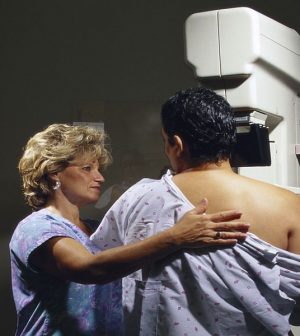- Understanding the Connection Between Anxiety and Depression
- How Daily Prunes Can Influence Cholesterol and Inflammation
- When to Take B12 for Better Absorption and Energy
- Epsom Salts: Health Benefits and Uses
- See What Saffron Can Do for Sleep and Heart Health
- 6 Common Mistakes to Avoid Before Your Physical
- Can Sweating Really Help You Beat a Cold?
- Strengthening Your Relationship: Practical Strategies
- Skip Storing This Everyday Product in the Fridge Door
- Green Tea + B3 Pairing May Boost Brain Health
Medicaid Cuts Tied to Delayed Breast Cancer Diagnoses

As Congress takes aim at replacing “Obamacare,” a new study says Medicaid cuts could boost the number of women diagnosed with late-stage breast cancer.
The study looked at what happened after a budget crunch caused Tennessee to cut nearly 170,000 people from its Medicaid rolls in 2005.
Within the next few years, the researchers found, late-stage breast cancer cases rose in low-income areas of the state.
“We can’t say that Medicaid disenrollment was the direct cause,” said researcher Lindsay Sabik, an associate professor at the University of Pittsburgh.
But, she said, there was clearly a correlation.
The findings come at a crucial time: Republicans in both houses of Congress have proposed legislation that would cut off federal funding for Obamacare’s expansion of Medicaid. Medicaid is a government program that helps millions of low-income Americans pay their medical bills.
“It’s important for the current debate to consider the potential impact of Medicaid disenrollment on people’s health outcomes,” Sabik said.
Before 2005, she noted, Tennessee had a relatively generous Medicaid program. It went beyond the typical income limits, and offered coverage to individuals with incomes up to 400 percent of the federal poverty line.
The 2005 rollback — spurred by the state’s financial troubles — brought back traditional income limits. The result: Roughly 170,000 Tennesseans lost Medicaid coverage.
Sabik’s team looked at whether that corresponded to an increase in late-stage breast cancer diagnoses.
Because of mammography screening, many U.S. women have breast cancer detected early. So any increase in late-stage cancers would suggest women had less access to routine health care, Sabik explained.
Late-stage cancer diagnoses did, in fact, rise, the study found.
Among women living in low-income zip codes, 40 percent of breast cancers diagnosed between 2005 and 2008 were late-stage. That was up from 35 percent in the three years before the Medicaid cuts.
The study found an increase among women living in higher-income zip codes, too. But the change was smaller: Between 2005 and 2008, just over 36 percent of breast cancers were diagnosed at a late stage — compared to just under 35 percent before the Medicaid rollback.
“Late stage” means the cancer has spread beyond the breast.
Sabik acknowledged the study’s limitations. “We couldn’t follow individual women and see how their insurance coverage changed,” she said.
So instead, the researchers looked at wider patterns — reasoning that women in low-income zip codes would be more affected by Medicaid cuts than those in higher-income areas.
Low-income areas were those with a median yearly income of $38,700 or less, meaning half of people living there made more, half less.
The findings were published June 26 in the journal Cancer.
Would the experience in Tennessee necessarily predict what could happen if Medicaid expansion is rolled back nationwide?
Sujha Subramanian thinks so. Subramanian, a researcher with the nonprofit RTI International, co-wrote an editorial published with the study.
“If you take Medicaid away from low-income people, where do they go?” she said.
Low-income women can get free mammograms and Pap tests through the National Breast and Cervical Cancer Early Detection Program, Subramanian pointed out.
Without the program, she noted, the findings would probably have been “worse.”
But that program won’t make up for Medicaid cutbacks: It only reaches around 20 percent of eligible women, according to Sabik.
Subramanian agreed. “We know it’s better to have continuous coverage and contact with the health care system,” she said.
Even from a financial standpoint alone, Medicaid cuts may not “make sense,” according to Subramanian.
Once a low-income woman is diagnosed with breast cancer, she may be eligible for Medicaid coverage of her treatment.
“And it’s much more expensive to treat later-stage cancer than early stage,” Subramanian said.
In a previous study, she estimated that Medicaid pays, on average, just over $19,000 in the year after a woman is diagnosed with earlier-stage breast cancer. That spikes to about $63,000 if the cancer has already spread to distant sites in the body.
This new study looked only at breast cancer, Subramanian added. Medicaid cuts could also affect detection of other major diseases, such as colon cancer and diabetes.
As for breast cancer treatment, women in Tennessee faced more delays after 2005, the study found.
But that change was even greater for women in higher-income zip codes: By 2008, about 14 percent of women in both low- and higher-income areas waited more than 60 days for surgery.
It’s not clear why, Sabik said.
But, she added, it might be because wealthier women have more choices. Some may delay surgery to get a second opinion, she said, or to have breast reconstruction at the same time as their cancer surgery.
More information
For more on cancer screening for low-income women, visit the U.S. Centers for Disease Control and Prevention.
Source: HealthDay
Copyright © 2026 HealthDay. All rights reserved.










